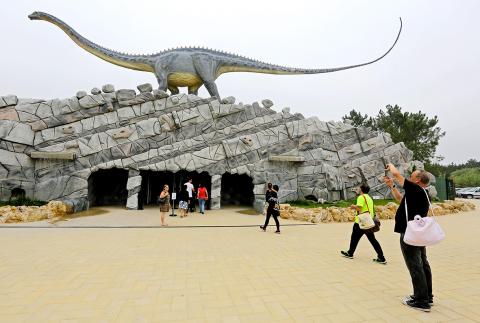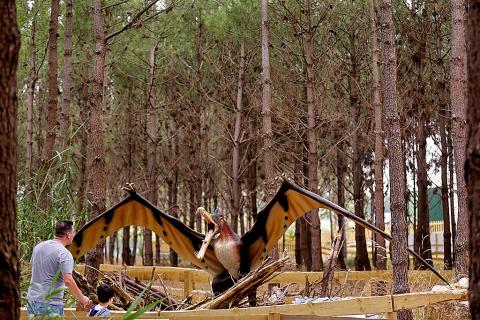Eyes popping in astonishment, his mouth hanging mutely open, seven-year-old Joel approaches the four-meter-high monster and stands nose-to-nose with one of the deadliest killing machines the world has ever known. The full-scale Tyrannosaurus rex is just one of the prehistoric highlights on display at Portugal’s self-proclaimed “dinosaur capital,” a new theme park in one of the most fossil-rich regions in Europe. “We have 120 large-scale reproductions of 70 different species, spread over 10 hectares,” Simao Mateus, Dino Park’s scientific director said. Although only recently opened, the park sits in a part of Portugal long famous among paleontologists for its extraordinary array of fossilized remains. The nearby town of Lourinha, an hour’s drive north of Lisbon, has been dinosaur-mad ever since the remains of a dozen of the creatures were discovered in the late 19th century. It already has a dinosaur museum and dinosaur statues in metal or resin can be seen on its roundabouts, while pavements are decorated with paintings of dinosaur footprints.
“Lourinha is quite particular about its dinosaurs, so we should all enjoy” the new facility, Mateus said. Visitors to the park are greeted by the rearing neck of a giant model Supersaurus, one of the largest dinosaur genera, announcing a collection as impressive as anything else to be found in Europe. Imported from Germany, the resin statues are dotted throughout a forest route guiding budding paleontologists through the eons when dinosaurs stalked the Earth.
Pride of place goes to two models of dinosaurs actually discovered in the town. Lourinhasaurus was a sauropod — an immense, four-legged herbivore similar to Brachiosaurus or Diplodocus — that roamed the rainforests of western Laurasia around 150 million years ago. That gentle giant is not to be confused with Lourinhanosaurus, a sharp-fanged and crafty hunter the size of a crocodile that lived in roughly the same era as Lourinhasaurus.

Photo: AFP
‘CREATURES FROM THEIR DREAMS’
Mateus says interest in the park has started strong, with 175,000 visitors through the gates in the six months since opening, despite a prolonged period of poor weather. On this visit, to the backdrop of the roars and squawks of dinosaurs of all shapes and sizes, a gaggle of young schoolchildren gape up in awe at the T-rex, its huge jaws capable of gobbling each one in a single gulp. Other little ones cluster around a model Iguanodon — a Cretaceous-era grazer — though one boy keeps his distance from the reptile’s giant spiky thumb. For park employee Filipa Pedro, who has been handing out stone blocks, hammers, chisels and other tools to this next generation of geologists, the experience offers children a glance of a long-lost part of the planet’s past.
“Children love dinosaurs, they are like these mysterious creatures that come from their dreams,” she says. “Thanks to lots of cartoons and films on the subject, their knowledge is impressive. So this park is bound to please them.”

Photo: AFP

One of the biggest sore spots in Taiwan’s historical friendship with the US came in 1979 when US president Jimmy Carter broke off formal diplomatic relations with Taiwan’s Republic of China (ROC) government so that the US could establish relations with the People’s Republic of China (PRC). Taiwan’s derecognition came purely at China’s insistence, and the US took the deal. Retired American diplomat John Tkacik, who for almost decade surrounding that schism, from 1974 to 1982, worked in embassies in Taipei and Beijing and at the Taiwan Desk in Washington DC, recently argued in the Taipei Times that “President Carter’s derecognition

This year will go down in the history books. Taiwan faces enormous turmoil and uncertainty in the coming months. Which political parties are in a good position to handle big changes? All of the main parties are beset with challenges. Taking stock, this column examined the Taiwan People’s Party (TPP) (“Huang Kuo-chang’s choking the life out of the TPP,” May 28, page 12), the Democratic Progressive Party (DPP) (“Challenges amid choppy waters for the DPP,” June 14, page 12) and the Chinese Nationalist Party (KMT) (“KMT struggles to seize opportunities as ‘interesting times’ loom,” June 20, page 11). Times like these can

June 23 to June 29 After capturing the walled city of Hsinchu on June 22, 1895, the Japanese hoped to quickly push south and seize control of Taiwan’s entire west coast — but their advance was stalled for more than a month. Not only did local Hakka fighters continue to cause them headaches, resistance forces even attempted to retake the city three times. “We had planned to occupy Anping (Tainan) and Takao (Kaohsiung) as soon as possible, but ever since we took Hsinchu, nearby bandits proclaiming to be ‘righteous people’ (義民) have been destroying train tracks and electrical cables, and gathering in villages

Dr. Y. Tony Yang, Associate Dean of Health Policy and Population Science at George Washington University, argued last week in a piece for the Taipei Times about former president Ma Ying-jeou (馬英九) leading a student delegation to the People’s Republic of China (PRC) that, “The real question is not whether Ma’s visit helps or hurts Taiwan — it is why Taiwan lacks a sophisticated, multi-track approach to one of the most complex geopolitical relationships in the world” (“Ma’s Visit, DPP’s Blind Spot,” June 18, page 8). Yang contends that the Democratic Progressive Party (DPP) has a blind spot: “By treating any